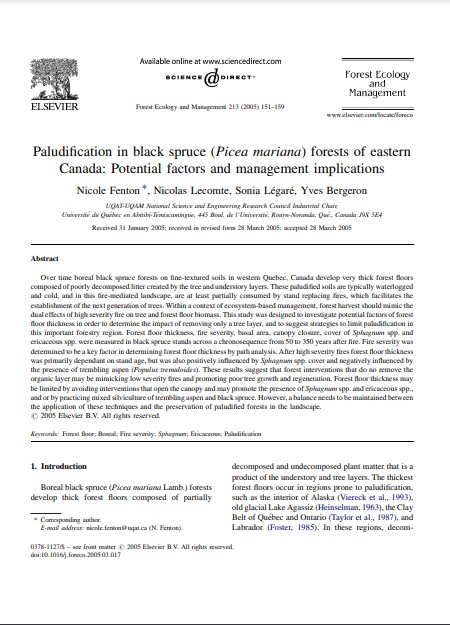Paludification in black spruce (Picea mariana) forests of eastern Canada: Potential factors and management implications
Bosque Modelo:
Lake Abitibi
Temática:
Gestión forestal
Tipo de documento:
Artículo científico
Resumen
Over time boreal black spruce forests on fine-textured soils in western Quebec, Canada develop very thick forest floors composed of poorly decomposed litter created by the tree and understory layers. These paludified soils are typically waterlogged and cold, and in this fire-mediated landscape, are at least partially consumed by stand replacing fires, which facilitates the establishment of the next generation of trees. Within a context of ecosystem-based management, forest harvest should mimic the dual effects of high severity fire on tree and forest floor biomass. This study was designed to investigate potential factors of forest floor thickness in order to determine the impact of removing only a tree layer, and to suggest strategies to limit paludification in this important forestry region. Forest floor thickness, fire severity, basal area, canopy closure, cover of Sphagnum spp. and ericaceous spp. were measured in black spruce stands across a chronosequence from 50 to 350 years after fire. Fire severity was determined to be a key factor in determining forest floor thickness by path analysis. After high severity fires forest floor thickness was primarily dependant on stand age, but was also positively influenced by Sphagnum spp. cover and negatively influenced by the presence of trembling aspen (Populus tremuloides). These results suggest that forest interventions that do no remove the organic layer may be mimicking low severity fires and promoting poor tree growth and regeneration. Forest floor thickness may be limited by avoiding interventions that open the canopy and may promote the presence of Sphagnum spp. and ericaceous spp., and or by practicing mixed silviculture of trembling aspen and black spruce. However, a balance needs to be maintained between the application of these techniques and the preservation of paludified forests in the landscape.
Información Bibliográfica
Autor:
Fenton, N, N Lecomte, S Légaré and Y Bergeron.
Revista:
Forest Ecology and Management
Año:
2005
N°:
-
País :
Canadá
Páginas:
151 - 159
Volumen:
213
Idioma:
Ingles
Palabras claves
Forest floor; Boreal; Fire severity; Sphagnum; Ericaceous; Paludification





